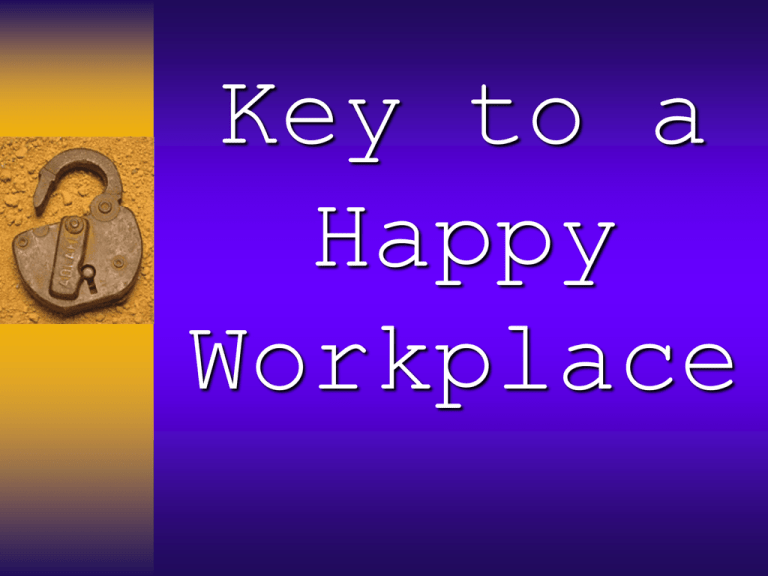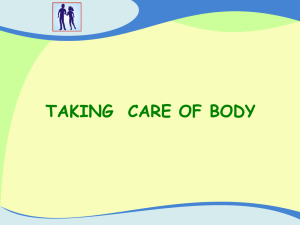
Key to a
Happy
Workplace
Three steps to
the happy workplace
1.Happy customers
2.Happy employees
3.Happy employers
The Happy Customer
Good customer service is all about bringing
customers back. And about sending them
away happy, happy enough to pass positive
feedback about the restaurant to others.
If you are a good waiter you will be able to
sell anything to anyone. But it will be your
approach to customer service that
determines whether or not you’ll ever get
the customer to come back.
Here are a few points that will ensure that
you are the best that you can be at all
times.
• Listen to your customer/fellow employees
There is nothing more annoying then telling someone what you want or what
your problem is and then discover that the person hasn’t been paying
attention and then you will have to explain it again. Let your customer talk
and show him that you are listening by making the appropriate responses,
such as suggestive selling.
• Be Helpful – even if there’s no immediate profit in it.
Remember that even if you not serving the table today or going on lunch,
but attending to the immediate needs of the company it will eventually pay
off.
• Trained staff
Know all the key elements of your job on the palm of your hand
• Take the extra step
If there is a child at the table give the child some extra attention. The
child will remember you and the parents are sure to return. Clean, neat,
warm and correct food presentation will always bring a customer back.
• Throw in something extra
Make the customers experience in the store memorable. Make a statement.
Remember you are not just a waiter or back of house staff member. You
are sales person, you sell the product on the menu, you market the store and
you have to make the customer remember the store. Write
you please come again on the till slip.
thank
The happy employee
Ask yourself the following
questions
•
•
•
•
•
•
•
•
•
•
•
•
Why am I here?
Do I know what is expected of me at work?
Am I capable of doing the job that’s required of me?
Do I have the materials and equipment I need to do my
work right?
Does my supervisor, or someone at work, seem to care
about me as a person?
Is there someone at work who encourages my development?
At work, do my opinions count?
Are my co-workers committed to doing quality work?
Do I have a best friend at work?
Do you feel that you are the best that you can be?
At work, have I had opportunities to grow?
Do I have a good relationship with my boss?
The happy employer
What does my boss expect from me
• To be the best that you can be at all times.
• To be on time for work.
• To be pro-active all the time. (Never walk past a
dirty table or over dirt lying on the floor. Help in
all the sections if needed)
• Respect the company rules and procedures,
respect the equipment, respect yourself and your
co-workers.
• Be a team player.
• Leave your personal issues at home.
• Prevention is better then cure, if you do have a
customer complaint bring it to the managers
attention immediately.
How does it all come together
• We all work as a chain, one can not function
without the other one. If there’s a weak link in the
chain the chain is bound to break and it will be
detrimental to our business.
• Everyone is here to perform a certain function
from the customer that brings in the cash to every
single staff member that performs the duty the
customer pay’s for..
• Without the company there will be no place the
customer can spend their money, without staff the
company will not function and without the
customer we will have no cash flow to pay the
staff..
Four important words
• Pride – In who you are and what you do
• Passion – For the work you do
• Commitment – Towards customers and the
company
• Respect – For yourself, your job and each
other
Company guidelines for dealing
with a dissatisfied customer
When a customer pays for a product, it is
assumed that the product will be correct and
as promised. Ideally the customer will be
satisfied, and there will be no complaints.
If there is a problem and the customer
complains about it, your company should
quickly listen to the complaint and solve the
problem
Always follow the following guidelines:
B.L.A.S.T.
• Believe
• Yes, the customer may be lying and be incorrect
about their situation. It is important to
understand that your customer believes that
they have been wronged
• Listen
• Stop and listen to your customer’s
complaint. As soon as a customer starts to
complain, we start to think of how we will
respond to the accusation before we are
done listening. Take a second relax and
listen. On occasion a complaining
customer will be rude, angry and use
vulgar language. Stay calm and level
headed at all times.
• Apologize
• Always apologize even if you did nothing
wrong. From a customers perspective,
they have reason to complain and expect
an apology. It could be as simple as “I am
really sorry we’ve inconvenienced your”
or “I’m sorry I know how frustrating it is
to receive the wrong order.
• Satisfy
• Make it right. Ask the customer “What
can I do to make this right for you?” Be
the judge of what is fair of course, but
allow them the opportunity to feel
empowered over the situation. Many
times the problem can be taken care of on
their next visit or that you will talk to the
person who made the mistake and correct
them.
• Thank
• At the beginning, at the end, in the middle it
doesn’t matter, thank the customer for calling and
complaining.
• Why? With the simple act of complaining your
customer is telling you “ I care about your
business enough to bring to your attention that
there is a problem”
• After handling the complaint thank customer for
giving you that second chance and letting you
know that something in the restaurant didn’t
work like it normally does and for giving you the
chance to make it right and for the opportunity
not to damage your reputation.
Personal Hygiene
Food Hygiene
There are many levels of Hygiene
but for today’s presentation we will
only discuss:
Personal Hygiene
Food Hygiene
Meaning of the word
Hygiene (clip)
What words do we associate with Hygiene
* Cleanliness
* Sanitation
* Bacteria free
* Spotlessness
To be hygienic means to be clean on
yourself on your equipment and your working
tools
Personal Hygiene
Hygiene starts right at home. Personal
hygiene is important as the bacteria we carry
in and on our bodies can easily be
transferred through our normal everyday
actions. This means that we contaminate
food that other people eat by little things like
scratching our faces and then touching food.
We need to understand how our own
personal hygiene can affect other people’s
health and how we can prevent making
people sick.
Key’s to personal hygiene
(clip)
Bathing
Teeth
Hair
Uniform
Cuts, burns and sores
Bad habits
Hands
Big no - no’s on
Personal Hygiene
Whilst handling food you must not eat or chew gum,
you’ll generate saliva that may get into food
Never lick your fingers or blow on food or things that
come into contact with food, for ex. bread bag’s
Avoid touching your face and especially your nose,
mouth or ears whilst handling food. If you do, wash
your hands immediately
Never cough or sneeze over food or food equipment
If you need to blow your nose, do it away from food,
using a paper tissue (not your apron) throw used
paper tissues away immediately and do wash your
hands straight away.
Food Hygiene
Food Hygiene
Protecting food from risk of
contamination, including harmful
bacteria, poisons and foreign bodies
Preventing any bacteria present from
multiplying to an extent which would
result in the illness of customers or the
early spoilage of the food
Destroying any harmful bacteria in the
food by thorough cooking or processing
The cost of poor hygiene
Food poisoning outbreaks and sometimes death
Food contamination and customer complaints
Pest infestations
Waste food due to spoilage
The closure of food premises by local authority action
Fines and costs of legal action taken because of contraventions
in hygiene legislation, or because of the sale of unfit or
unsatisfactory food
Civil action taken by food poisoning sufferers; poor hygiene can
result in food complaints, illness and fines
Loss of production and food which has to be destroyed
Decontamination, cleaning and replacement of damaged
equipment
All of the above factors will contribute to a lowering of profits.
The benefits of good hygiene
Satisfied customers, a good reputation
and increased business
Compliance with the law
Increased shelf life of food
Good working conditions, higher morale
and lower staff turnover, which
promote increased productivity
All above factors will contribute to higher
profits
Food quality,
preparation and
presentation
Basic guidelines to food quality
• It’s not only up to the waitress to give good service,
it is up to the whole store to ensure excellent
service.
• How do we do that?
• Proper preparation and cooking of
products
• Proper plate presentation. Our food
is advertised on the menu and the
customer expects to get what he
sees
Proper plate presentation
• There is nothing worse than to get a plate of food
when it looks like the food was picked up from the
floor and put on the plate.
• Over cooked food looks like its been cooked the
day before.
• Over portioning and under portioning of food sends
out the wrong message to the customers. The
customer pays for the right portion of food. Under
portioning of the food will leave customers unhappy
and they will feel like they have been cheated.
• Over portioning sends out the wrong message as
the customer will always expect this portion of food
at all Wimpy’s at all times.
Proper cooking of products
• There is a cooking chart in the grill area explaining
the proper cooking times of products.
• Temperatures of equipment is also essential as
equipment that is too hot or cold will leave food either
under or over cooked.
• All steak, chops, lamb sausages and boerewors
should be cooked on the chargrill and not on the
griddle. Fish should only be cooked in the fish fryer.
• The right milk for Premium Blend should be used and
not milk out of the Urn. Steamed milk should not be
used for Wimpy coffee.
• Everything we do influences the taste of the food and
will determine if the customer will return or not
Wastage and stock rotation
• Keeping stock wastage at a minimal without
giving a customer a poor quality product is
essential.
• Stock rotation is essential as old stock
should be sold before new stock. Should
you prepare the new stock first the old stock
is bound to go off and will be thrown away.
• Last in first out rule applies at all times.
Equipment
Equipment
The safe handling and cleaning of equipment
is essential to our business.
Without the proper equipment, that’s in
working order all of the time, we will not be
able to do our work properly
It’s our responsibility to look after and care
for our equipment at all times
Equipment includes crockery and cutlery as
well.
Broken equipment
The minute you realise that equipment is broken its
your responsibility to report it immediately. There is
an equipment report book where this should be
written down
The quicker you report it the quicker we can get it
fixed.
Failing to report broken equipment could lead to
disciplinary procedures as the equipment we work
with is very expensive and should be handled with
the utmost care.
Remember broken equipment can be dangerous to
yourself and others around you.
Cleaning equipment
Equipment should be cleaned on a daily
basis
Equipment should not be cleaned during
peak periods
Equipment must be un plugged before
cleaning
Oil should never be left in equipment over
night
Ensure that all equipment is unplugged and
switched off at main board over night.
Company
guidelines for
dealing with
a robbery
Preventing a Robbery
At least two staff should open and close the store
Keep all doors and windows clear of signs and posters.
Make direct eye contact with ever customer. This serves to
improve customer service and most important it sends a
message to those entering that they have been recognized.
Keep low cash balance in the till handle cash carefully and cash
up in secure area
Be careful, most robbers are just as nervous as you
Stay alert. Know who is in the store and where they are. Also
be suspicious of activity outside the shop.
If you see something suspicious, press the panic button
immediately, rather safe then sorry
Keep back doors locked at all times
What to do during a robbery
Remain calm. Press the panic button immediate
There is no need to bring attention to the situation. To do
so could cause the robber to panic and endanger lives.
Cooperate. Robbers seldom hurt people who are willing
to cooperate.
Observe what the robber looks like and develop a mental
picture so you can provide an accurate description
Tell the robber about any possible surprises such as
other employees who may be working at the back.
Inform robber of any moves you have to make.
What not to do during a
robbery
Never argue or fight with the robber. No amount of money is
worth it.
Don’t give chase or follow the robber.
Don’t go into a panic, stay as calm as possible at all times.
Don’t run out of the shop
Don’t scream or shout at the robber
Don’t make any sudden movements that could scare the robber
What to do after a robbery
Don’t move anything around. Leave everything as it is.
Don’t clean up or touch anything
Close the shop doors and lock them
Phone the police
Phone ambulance should any one got hurt
Ask witnesses to stay until police arrives. If they unable to
do so, write down their names, address and phone
numbers.
Write down a description of the robber including sex, race,
height, weight, build, eye and hair colour, scars, tattoos,
jewellery, age and clothing












